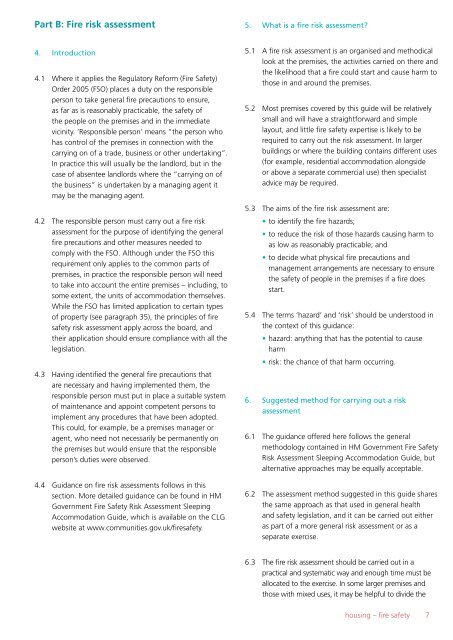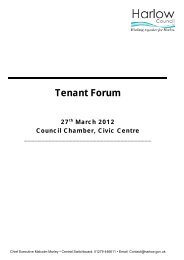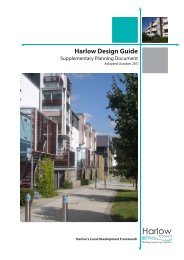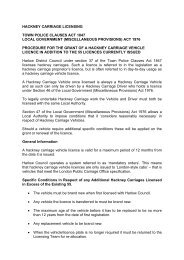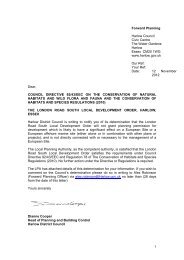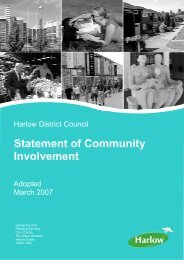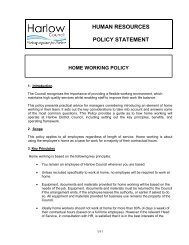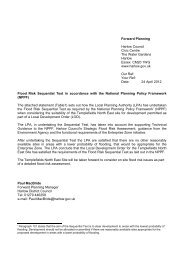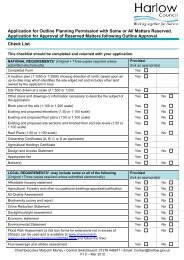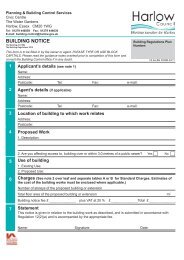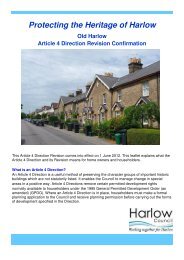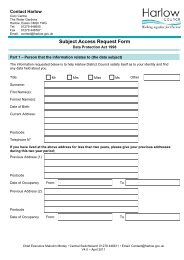HMO fire safety guidance - Harlow Council
HMO fire safety guidance - Harlow Council
HMO fire safety guidance - Harlow Council
Create successful ePaper yourself
Turn your PDF publications into a flip-book with our unique Google optimized e-Paper software.
Part B: Fire risk assessment<br />
5. What is a <strong>fire</strong> risk assessment?<br />
4. Introduction<br />
4.1 Where it applies the Regulatory Reform (Fire Safety)<br />
Order 2005 (FSO) places a duty on the responsible<br />
person to take general <strong>fire</strong> precautions to ensure,<br />
as far as is reasonably practicable, the <strong>safety</strong> of<br />
the people on the premises and in the immediate<br />
vicinity. ‘Responsible person’ means “the person who<br />
has control of the premises in connection with the<br />
carrying on of a trade, business or other undertaking”.<br />
In practice this will usually be the landlord, but in the<br />
case of absentee landlords where the “carrying on of<br />
the business” is undertaken by a managing agent it<br />
may be the managing agent.<br />
4.2 The responsible person must carry out a <strong>fire</strong> risk<br />
assessment for the purpose of identifying the general<br />
<strong>fire</strong> precautions and other measures needed to<br />
comply with the FSO. Although under the FSO this<br />
requirement only applies to the common parts of<br />
premises, in practice the responsible person will need<br />
to take into account the entire premises – including, to<br />
some extent, the units of accommodation themselves.<br />
While the FSO has limited application to certain types<br />
of property (see paragraph 35), the principles of <strong>fire</strong><br />
<strong>safety</strong> risk assessment apply across the board, and<br />
their application should ensure compliance with all the<br />
legislation.<br />
4.3 Having identified the general <strong>fire</strong> precautions that<br />
are necessary and having implemented them, the<br />
responsible person must put in place a suitable system<br />
of maintenance and appoint competent persons to<br />
implement any procedures that have been adopted.<br />
This could, for example, be a premises manager or<br />
agent, who need not necessarily be permanently on<br />
the premises but would ensure that the responsible<br />
person’s duties were observed.<br />
4.4 Guidance on <strong>fire</strong> risk assessments follows in this<br />
section. More detailed <strong>guidance</strong> can be found in HM<br />
Government Fire Safety Risk Assessment Sleeping<br />
Accommodation Guide, which is available on the CLG<br />
website at www.communities.gov.uk/<strong>fire</strong><strong>safety</strong>.<br />
5.1 A <strong>fire</strong> risk assessment is an organised and methodical<br />
look at the premises, the activities carried on there and<br />
the likelihood that a <strong>fire</strong> could start and cause harm to<br />
those in and around the premises.<br />
5.2 Most premises covered by this guide will be relatively<br />
small and will have a straightforward and simple<br />
layout, and little <strong>fire</strong> <strong>safety</strong> expertise is likely to be<br />
required to carry out the risk assessment. In larger<br />
buildings or where the building contains different uses<br />
(for example, residential accommodation alongside<br />
or above a separate commercial use) then specialist<br />
advice may be required.<br />
5.3 The aims of the <strong>fire</strong> risk assessment are:<br />
• to identify the <strong>fire</strong> hazards;<br />
• to reduce the risk of those hazards causing harm to<br />
as low as reasonably practicable; and<br />
• to decide what physical <strong>fire</strong> precautions and<br />
management arrangements are necessary to ensure<br />
the <strong>safety</strong> of people in the premises if a <strong>fire</strong> does<br />
start.<br />
5.4 The terms ‘hazard’ and ‘risk’ should be understood in<br />
the context of this <strong>guidance</strong>:<br />
• hazard: anything that has the potential to cause<br />
harm<br />
• risk: the chance of that harm occurring.<br />
6. Suggested method for carrying out a risk<br />
assessment<br />
6.1 The <strong>guidance</strong> offered here follows the general<br />
methodology contained in HM Government Fire Safety<br />
Risk Assessment Sleeping Accommodation Guide, but<br />
alternative approaches may be equally acceptable.<br />
6.2 The assessment method suggested in this guide shares<br />
the same approach as that used in general health<br />
and <strong>safety</strong> legislation, and it can be carried out either<br />
as part of a more general risk assessment or as a<br />
separate exercise.<br />
6.3 The <strong>fire</strong> risk assessment should be carried out in a<br />
practical and systematic way and enough time must be<br />
allocated to the exercise. In some larger premises and<br />
those with mixed uses, it may be helpful to divide the<br />
housing – <strong>fire</strong> <strong>safety</strong> 7


